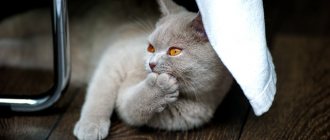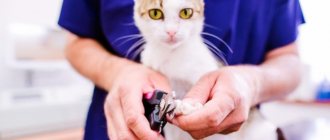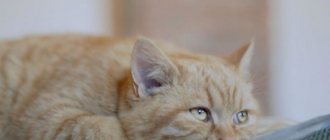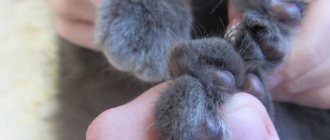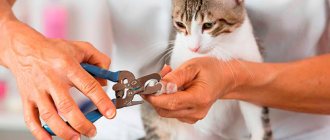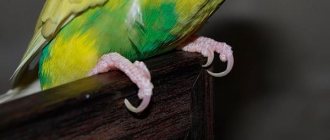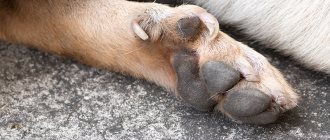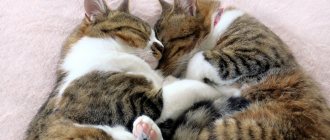In the wild, cats needed their claws to hunt, defend themselves, and survive. Claws enable cats to climb tall trees and get food.
Times have changed and cats have turned from wild animals into domestic ones that need care, just like their claws.
What number of claws is normal for a cat, what functions they perform - you will learn about this from the material. And also get useful tips on caring for your pet.
Cats in the wild
The structure and functions of a cat's claws
Tendons provide the process of stretching the claws
The cat's limbs have five fingers that end in claws. The extreme phalanges of the fingers are covered with curved keratinized tips - claws. The claws are smoothly retracted into the skin pouches, thanks to the tendons responsible for this process. The ability to retract the claws allows them not to touch the floor and not get worn down while walking.
“The lightness of a cat’s gait is explained by the fact that there are sensitive leather pads on its paws.”
The cat's limbs have leather pads that allow her to walk silently. They are equipped with highly sensitive nerve endings and blood vessels. In addition, these pads contain sweat glands that are absent on the rest of the body. The purpose of these glands is to mark their territory. So, when a cat scratches any surface, it leaves droplets of its sweat on it.
Claws allow animals to grab prey and also use them in defense.
Home manicure
You can do your pet's manicure yourself. You need to have enough skill, be careful and be patient.
Photo: You can do a cat manicure yourself
At the pet store you can purchase special products for caring for cat claws: pruning shears, special files and scissors.
The cutting procedure itself is quite simple and completely painless for the animal. You just need to carry it out carefully.
Many people don’t know how to trim a domestic cat’s claws, so they often turn to a veterinarian. To begin, calm your pet and stabilize him, then gently press on the pads of his paws.
In the light you will see that one half of the claw is lighter and the other is darker due to the nerves and blood vessels located there. You won't be able to give a cat a manicure with simple scissors.
Carefully place the white part into the pruner hole and, making sure that the sensitive half is not affected, quickly cut it off. Then you can sand the uneven edges with a nail file.
If blood vessels are accidentally damaged, immediately cauterize the wound with alcohol or hydrogen peroxide.
Why does a cat sharpen its claws?
It is necessary to care for a cat’s claws from the first month of their life. They can sharpen their claws with their teeth and scratch walls and furniture with them - which can cause discomfort to their owners. Pets scrape off the dead outer shell of their claws in this way. Therefore, in an undesirable place where the animal scratched, you can find a “lost claw,” namely the very dead cornea of the claw.
Sharpening a cat's claws is a natural, necessary process.
In addition, by scratching various objects, the cat marks its territory. Not only by the remaining traces, but also by the secretion of the glands located on the back of the limbs. Their movements contribute to the release of this secretion with an odor and rubbing it into fabric or other things.
A kind of training for the claw release mechanism, which is important for grasping prey and climbing trees, is the reason why they scratch hard surfaces. This habit, characteristic of wild cats, has been preserved by them centuries later.
When should you trim your cat's nails?
Cats should have their nails trimmed regularly starting from the age of one month. It is desirable that this procedure be regular and familiar to the cat. Particular attention should be paid to pets - residents of city apartments. They have very little room to move and little opportunity to sharpen their claws in natural conditions. In such animals, the claws grow faster, and the cat can scratch their owners or the floor and furniture in the house with them.
How many claws does a cat have on its hind and front paws?
Mammals have five-fingered limbs. The cat differs from other mammals in that it has 18 toes, each with one claw.
How many fingers does a cat have, so many nails?
The number of claws on the front and hind limbs is different. There are five fingers in front - ten claws. The hind ones have four fingers, which means eight claws.
Four fingers with claws are located in one row, and the fifth with a claw is slightly protruded to the side, which allows it not to touch the floor surface when walking. The fifth finger is vestigial.
Declaw surgery
The last resort in the fight against cat hooliganism is complete declawing. In society you can find completely opposite opinions about such medical intervention.
Photo: complete declawing is a very dangerous operation
Some believe that the operation saves the animal from constant claw jams and subsequent suffering, and the person from unpleasant scratches and damaged furniture.
However, many, including animal protection organizations, are confident that such a dangerous operation will only bring suffering to the pet, since it deprives it of a natural universal tool for climbing, hygiene and self-defense, and can lead to blood poisoning, paw deformation and death.
It is also worth considering that this type of surgery involves removing the top of the cat's toes.
If you didn’t succeed in taming the animal to use a scratching post, and partial cutting of the claws does not solve the problem, but you still decide to completely remove the source of trouble, you should contact a veterinary clinic.
Under no circumstances attempt to perform the operation yourself! One wrong move can lead to severe hemorrhage and even death of the animal.
The operation is performed under anesthesia using conventional instruments or a laser. The cat may be hospitalized for one to two days and kept in the clinic.
Remember that care after declawing surgery is quite complex:
- for the first week, you need to replace the usual tray filler with paper so that the granules do not stick to the incision sites;
- limit the animal from unnecessary physical activity, especially jumping;
- make sure that the seams do not come apart. If you notice bleeding that doesn't stop, call the clinic immediately.
Photo: the owner must show the cat where to sharpen its claws
Caring for a cat’s claws is a very important procedure that simply needs to be done regularly. The best solution would be to purchase a scratching post so that your pet can do its own manicure.
Caring for a pregnant cat is described in more detail in the article: Caring for a pregnant cat.
For how much you can buy a Bengal cat in Yekaterinburg, see on the page.
Find out what to feed your Bengal cat from this information.
The norm for the number of claws and deviations from it
How many toes mean how many claws a cat has on its hind and front paws?
Eighteen claws is the norm, which is confirmed by felinological organizations of the international level.
A mutation at the genetic level leads to the formation of additional fingers - polydactyly, and, accordingly, additional claws.
This anomaly does not affect the health of cats in any way. Additional claws can be located on different sides of the limb, and their functionality depends on this.
To cut or not to cut?
Why does a cat at home periodically attack various surfaces? It's simple - trying to get rid of the dead stratum corneum. Over time, the claw begins to peel off and becomes an annoying inconvenience in life.
There are many options to help her (and yourself!). Skipping completely barbaric methods that can ruin a cat’s life, at home the claws can be trimmed or covered with special attachments.
In this regard, a scratching post will help cope with frontal claws. True, on each front leg there are also spaced joints, the horny part of which quite often grows into the skin and becomes inflamed. They will still have to be trimmed.
It is up to the owner to decide how to deal with acute atavism. But at the same time, it is important to remember that free-range cats can cope quite well on their own: they have a natural ability to grind their claws off on trees or hard surfaces of paths. In addition, by depriving your cat of a weapon, you take away a couple of handicap points from your cat in a fight with a neighbor’s rival. And, of course, the pleasure of catching a mouse or climbing a tree.
Nail care
A pet's claws require special attention from its owner. Care should be taken to purchase a scratching post to prevent damage to property in the house.
It is important to interest the cat in this subject. You can rub it with mint and place it near the cat’s sleeping place, since after waking up they first sharpen their claws.
Cats' claws are not so much ground down as they are sharpened.
Periodically, the animal's nails need to be trimmed using a special nail clipper.
“Cutting nails is the most humane procedure for removing them.”
This process must be taught from childhood. Proper nail trimming does not cause any inconvenience to the animal. After such an event, it would not be superfluous to praise the cat for its endurance. For example, give a treat or cuddle.
Do I need to cut my hair?
The answer to this question is simple:
Turn the surface of the limb over and look at the tips of the claws. If they are not completely hidden in the pads, but protrude outward, then they need to be cut.
Cats' nails should be trimmed periodically
Cats kept indoors must have their nails trimmed. With their sharp claws, cats can cling to sofa upholstery and clothing, causing inconvenience to the owner and the animal. It is also worth trimming the claws if the animal behaves aggressively, thereby causing the risk of scratches.
For free-ranging animals, nail trimming is contraindicated for their safety. In a dangerous situation, a cat must be able to quickly climb a tree or jump to a height - this is impossible to do without sharp claws.
Important to remember!
Before cutting your cat's claws, you should know some nuances:
- If a cat is injured during nail trimming, the wound must be treated with hemostatic agents and antiseptics. When bleeding cannot be stopped for a long time, you should immediately contact a veterinarian.
- If the animal often behaves too aggressively during the procedure, nail trimming should be carried out later by a veterinarian.
- If you hit a blood vessel in the claw, severe bleeding may occur. If it is not treated in time, an inflammatory process will occur, which will lead to pain in the cat and swelling of the paw.
- You cannot forcibly hold a cat or kitten in your arms to trim its claws. If the animal behaves aggressively and breaks out, it is better to postpone this process until later.
- You cannot pick up an animal during play in order to trim its claws.
- Another claw grows on the back of a cat's front paws. He is not involved during scratching, but you shouldn’t forget about him either. Excessive growth of the fifth claw leads to its ingrowth into the skin and can cause painful shock in the animal.
- If you have a cat for the first time, then the first procedure for trimming your pet’s claws should be entrusted to a veterinarian who will show you how to do it correctly at home.
- In most cats, the claw is white or transparent, making it easy to see where the blood vessel runs. If the cat has black claws, then they should be trimmed to the minimum length.
How to trim a cat's claws
Before you start clipping, determine where the blood vessel ends on the claw. It is very important not to damage it!
Never cut your nails short, as you risk damaging a blood vessel, causing bleeding, and causing pain and stress to your cat.
If you damage a vessel, stop the bleeding with hydrogen peroxide.
“It is better to trim less, but more often, and for the first time it is recommended to consult a veterinarian. The doctor will show you how to trim your nails correctly.”
Using anti-scratch pads
Anti-scratch pads are “soft claws”. Special caps made of silicone, glued to the cat's claws. These tips stay on the claws for 4 to 8 weeks, preventing scratching.
It is important to consider the pros and cons before undertaking this procedure.
“Soft claws” do not allow cats to grind their claws down on their own, so there remains a need to trim them periodically.
In addition, when using soft claws, the cat does not have the ability to claw, which can limit its movement around the house.
Before purchasing silicone pads for your cat, you should listen to the advice of your veterinarian:
- Consult your veterinarian before performing this procedure, as the cat may have an individual intolerance or allergy to glue.
If irritation, swelling, or hyperemia (redness) appears on the toes and between them, you should consult a veterinarian.
The caps will most likely have to be removed and the animal given appropriate treatment.
- Apply silicone caps only to healthy animals that do not have fungal or infectious lesions. If there are wounds or irritation on the pads and between the toes, it is better to abandon soft claws for a while and treat the animal.
- Carefully apply the caps and regularly inspect the claws for infectious and fungal diseases, as various microorganisms can accumulate between the cap and the pad.
- Inspect the extremities daily for skin tension, which may be the result of inaccurate application of the adhesive.
Cat's claws are peeling - how to help
Cats' claws consist of several layers. Running the claws into a hard surface helps peel off the top layer, revealing a new, strong, sharp-tipped bottom layer.
There are several reasons for nail separation in a four-legged pet.
Causes of claw delamination:
- Natural renewal of the stratum corneum;
- Incorrect haircut;
- Avitaminosis.
The natural separation of a cat's claws occurs approximately once every two months - this means their growth. Animals themselves remove the unnecessary layer in the process of “turning” or remove it, like a small cover, with their teeth.
In case of a lack of vitamins, for example calcium, it is necessary to adjust the animal’s diet with the help of a veterinarian.
The cat tore off its claw: provide first aid
Sometimes it happens that a cat completely tears the claw out of its finger. This damage is more serious than a split or crack, and you will need to help your pet.
- Important: try not to panic. When a cat picks a claw and then is alone for a long time and moves around the house without hindrance, it can leave characteristic bloody marks. Perhaps there will be many of them. Don't be alarmed: as noted above, there are blood vessels in the living part of the claw, so bleeding can actually be profuse. This is not an indicator of the depth of the wound.
- Pay attention to the cat's behavior. If your pet doesn’t limp after being injured, it means it’s most likely not in pain. Temporarily limit his activity, do not play too active games and do not let the cat run around a lot.
- The wound must be disinfected with an antiseptic. Soak a cotton pad in Chlorhexidine and apply it to the finger with the claw removed. To get to the wound (especially if your pet is furry), gently apply pressure to the pad of the paw.
- There is no need to treat the damaged area with iodine and brilliant green: they corrode the wound and cause an unpleasant burning sensation. To stop bleeding, you can use Chemi spray, which is sold in veterinary pharmacies. The only disadvantage of this product is the purple color, so before treating the wound it is better to put your pet on a diaper, which you will not mind throwing away later.
- Do not allow your cat to lick the wound. If necessary, put a medical collar on the animal and cover the paw with a self-fixing bandage or plaster. You can put a baby sock in the smallest size on top, although most pets are not happy with foreign objects on their paws and will try their best to kick it off. Remember to change the bandages twice a day.
- As a rule, such wounds are not deep and heal on their own within 10-14 days, but if the damage is more serious, call a veterinarian at home or take the cat to the clinic.
- The good news is that the claw is not gone forever. It will definitely grow again, it will just take a lot of time - from a month to two.

